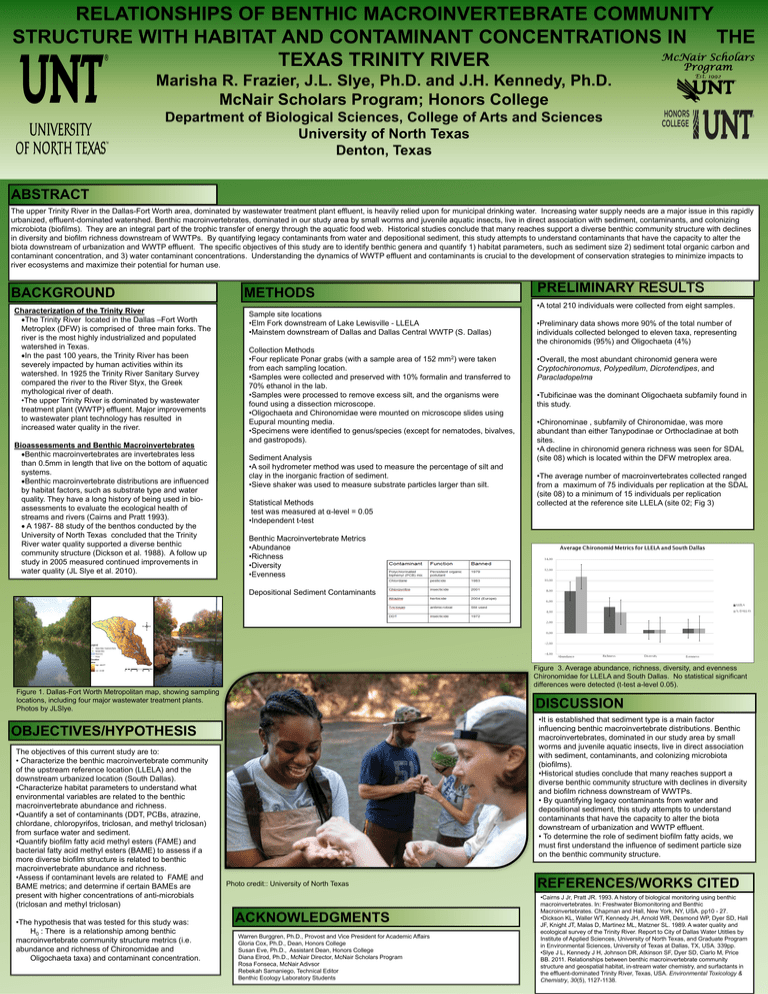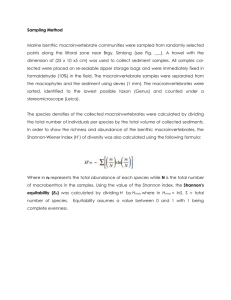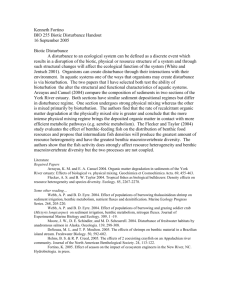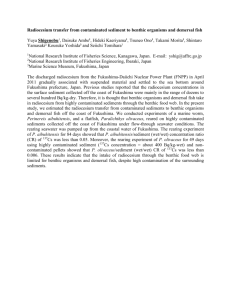Bioassessments and Benthic Macroinvertebrates
advertisement

RELATIONSHIPS OF BENTHIC MACROINVERTEBRATE COMMUNITY STRUCTURE WITH HABITAT AND CONTAMINANT CONCENTRATIONS IN THE TEXAS TRINITY RIVER Marisha R. Frazier, J.L. Slye, Ph.D. and J.H. Kennedy, Ph.D. McNair Scholars Program; Honors College Department of Biological Sciences, College of Arts and Sciences University of North Texas Denton, Texas ABSTRACT The upper Trinity River in the Dallas-Fort Worth area, dominated by wastewater treatment plant effluent, is heavily relied upon for municipal drinking water. Increasing water supply needs are a major issue in this rapidly urbanized, effluent-dominated watershed. Benthic macroinvertebrates, dominated in our study area by small worms and juvenile aquatic insects, live in direct association with sediment, contaminants, and colonizing microbiota (biofilms). They are an integral part of the trophic transfer of energy through the aquatic food web. Historical studies conclude that many reaches support a diverse benthic community structure with declines in diversity and biofilm richness downstream of WWTPs. By quantifying legacy contaminants from water and depositional sediment, this study attempts to understand contaminants that have the capacity to alter the biota downstream of urbanization and WWTP effluent. The specific objectives of this study are to identify benthic genera and quantify 1) habitat parameters, such as sediment size 2) sediment total organic carbon and contaminant concentration, and 3) water contaminant concentrations. Understanding the dynamics of WWTP effluent and contaminants is crucial to the development of conservation strategies to minimize impacts to river ecosystems and maximize their potential for human use. BACKGROUND Characterization of the Trinity River The Trinity River located in the Dallas –Fort Worth Metroplex (DFW) is comprised of three main forks. The river is the most highly industrialized and populated watershed in Texas. In the past 100 years, the Trinity River has been severely impacted by human activities within its watershed. In 1925 the Trinity River Sanitary Survey compared the river to the River Styx, the Greek mythological river of death. •The upper Trinity River is dominated by wastewater treatment plant (WWTP) effluent. Major improvements to wastewater plant technology has resulted in increased water quality in the river. Bioassessments and Benthic Macroinvertebrates Benthic macroinvertebrates are invertebrates less than 0.5mm in length that live on the bottom of aquatic systems. Benthic macroinvertebrate distributions are influenced by habitat factors, such as substrate type and water quality. They have a long history of being used in bioassessments to evaluate the ecological health of streams and rivers (Cairns and Pratt 1993). A 1987- 88 study of the benthos conducted by the University of North Texas concluded that the Trinity River water quality supported a diverse benthic community structure (Dickson et al. 1988). A follow up study in 2005 measured continued improvements in water quality (JL Slye et al. 2010). METHODS PRELIMINARY RESULTS •A total 210 individuals were collected from eight samples. Sample site locations •Elm Fork downstream of Lake Lewisville - LLELA •Mainstem downstream of Dallas and Dallas Central WWTP (S. Dallas) Collection Methods •Four replicate Ponar grabs (with a sample area of 152 mm2) were taken from each sampling location. •Samples were collected and preserved with 10% formalin and transferred to 70% ethanol in the lab. •Samples were processed to remove excess silt, and the organisms were found using a dissection microscope. •Oligochaeta and Chironomidae were mounted on microscope slides using Eupural mounting media. •Specimens were identified to genus/species (except for nematodes, bivalves, and gastropods). Sediment Analysis •A soil hydrometer method was used to measure the percentage of silt and clay in the inorganic fraction of sediment. •Sieve shaker was used to measure substrate particles larger than silt. Statistical Methods test was measured at α-level = 0.05 •Independent t-test •Preliminary data shows more 90% of the total number of individuals collected belonged to eleven taxa, representing the chironomids (95%) and Oligochaeta (4%) •Overall, the most abundant chironomid genera were Cryptochironomus, Polypedilum, Dicrotendipes, and Paracladopelma •Tubificinae was the dominant Oligochaeta subfamily found in this study. •Chironominae , subfamily of Chironomidae, was more abundant than either Tanypodinae or Orthocladinae at both sites. •A decline in chironomid genera richness was seen for SDAL (site 08) which is located within the DFW metroplex area. •The average number of macroinvertebrates collected ranged from a maximum of 75 individuals per replication at the SDAL (site 08) to a minimum of 15 individuals per replication collected at the reference site LLELA (site 02; Fig 3) Benthic Macroinvertebrate Metrics •Abundance •Richness •Diversity •Evenness Depositional Sediment Contaminants Figure 3. Average abundance, richness, diversity, and evenness Chironomidae for LLELA and South Dallas. No statistical significant differences were detected (t-test a-level 0.05). Figure 1. Dallas-Fort Worth Metropolitan map, showing sampling locations, including four major wastewater treatment plants. Photos by JLSlye. DISCUSSION •It is established that sediment type is a main factor influencing benthic macroinvertebrate distributions. Benthic macroinvertebrates, dominated in our study area by small worms and juvenile aquatic insects, live in direct association with sediment, contaminants, and colonizing microbiota (biofilms). •Historical studies conclude that many reaches support a diverse benthic community structure with declines in diversity and biofilm richness downstream of WWTPs. • By quantifying legacy contaminants from water and depositional sediment, this study attempts to understand contaminants that have the capacity to alter the biota downstream of urbanization and WWTP effluent. • To determine the role of sediment biofilm fatty acids, we must first understand the influence of sediment particle size on the benthic community structure. OBJECTIVES/HYPOTHESIS The objectives of this current study are to: • Characterize the benthic macroinvertebrate community of the upstream reference location (LLELA) and the downstream urbanized location (South Dallas). •Characterize habitat parameters to understand what environmental variables are related to the benthic macroinvertebrate abundance and richness. •Quantify a set of contaminants (DDT, PCBs, atrazine, chlordane, chloropyrifos, triclosan, and methyl triclosan) from surface water and sediment. •Quantify biofilm fatty acid methyl esters (FAME) and bacterial fatty acid methyl esters (BAME) to assess if a more diverse biofilm structure is related to benthic macroinvertebrate abundance and richness. •Assess if contaminant levels are related to FAME and BAME metrics; and determine if certain BAMEs are present with higher concentrations of anti-microbials (triclosan and methyl triclosan) •The hypothesis that was tested for this study was: H0 : There is a relationship among benthic macroinvertebrate community structure metrics (i.e. abundance and richness of Chironomidae and Oligochaeta taxa) and contaminant concentration. Photo credit:: University of North Texas ACKNOWLEDGMENTS Warren Burggren, Ph.D., Provost and Vice President for Academic Affairs Gloria Cox, Ph.D., Dean, Honors College Susan Eve, Ph.D., Assistant Dean, Honors College Diana Elrod, Ph.D., McNair Director, McNair Scholars Program Rosa Fonseca, McNair Adivsor Rebekah Samaniego, Technical Editor Benthic Ecology Laboratory Students REFERENCES/WORKS CITED •Cairns J Jr, Pratt JR. 1993. A history of biological monitoring using benthic macroinvertebrates. In: Freshwater Biomonitoring and Benthic Macroinvertebrates. Chapman and Hall, New York, NY, USA. pp10 - 27. •Dickson KL, Waller WT, Kennedy JH, Arnold WR, Desmond WP, Dyer SD, Hall JF, Knight JT, Malas D, Martinez ML, Matzner SL. 1989. A water quality and ecological survey of the Trinity River. Report to City of Dallas Water Utitlies by Institute of Applied Sciences, University of North Texas, and Graduate Program in Environmental Sciences, University of Texas at Dallas, TX, USA. 339pp. •Slye J L, Kennedy J H, Johnson DR, Atkinson SF, Dyer SD, Ciarlo M, Price BB. 2011. Relationships between benthic macroinvertebrate community structure and geospatial habitat, in-stream water chemistry, and surfactants in the effluent-dominated Trinity River, Texas, USA. Environmental Toxicology & Chemistry, 30(5), 1127-1138.






